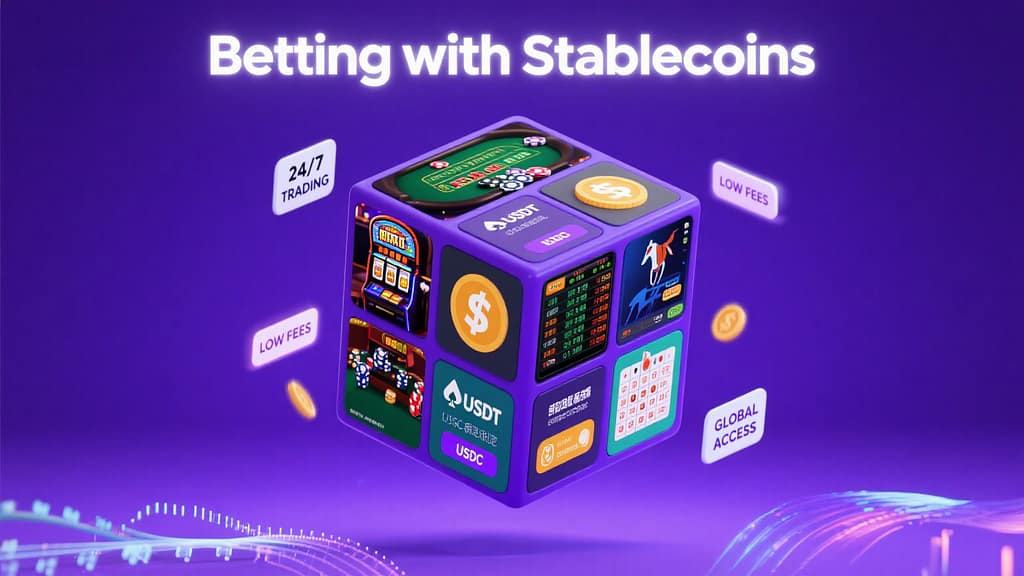Why stablecoins matter for sports bettors
Stablecoins are cryptoassets designed to track external references (usually the U.S. dollar) so their prices don’t swing like BTC or ETH—making them practical for payments and bankroll management. USDT (Tether) and USDC (Circle) are the most widely used dollar-pegged options.
Major crypto sportsbooks now accept these coins alongside BTC/ETH; for example, Sportsbet.io’s help center lists both USDT and USDC among supported currencies. Cloudbet advertises deposits with “40+ cryptocurrencies,” including USDT. Stake documents which networks it supports for each coin to prevent mis-sent funds.
Issuers publish reserve and transparency information: Circle provides monthly third-party assurance and frequent disclosure for USDC reserves, while Tether publishes quarterly attestations verified by BDO. These disclosures aim to show tokens are fully backed.
How stablecoins change the sportsbook experience
Faster deposits and withdrawals
Many operators process crypto withdrawals “instantly” once approved, with final timing depending on the blockchain’s congestion and confirmation policy. Sportsbet.io notes confirmations usually take a few minutes; Cloudbet’s help center highlights mostly instant processing, with occasional delays for manual checks.
Lower and predictable transfer costs
On USDC/USDT, fees depend on the network (e.g., Ethereum ERC-20 gas vs. Tron TRC-20 vs. Solana). Some books support multiple networks and let you choose during deposit/withdrawal to optimize fees and speed. Stake’s network list shows USDT available on ERC-20, TRC-20, BSC, Polygon, and Solana, with a reminder to match the exact chain.
Less price volatility
Unlike BTC/ETH balances, USDT/USDC are designed to hold near $1, reducing the chance your balance loses value while you wait for a market to settle. That stability is the core purpose of fiat-backed stablecoins.
Compliance still applies
Using stablecoins doesn’t exempt bettors from KYC where required. In Great Britain, the UK Gambling Commission requires remote operators to verify name, address, and date of birth before gambling, and to disclose a customer-funds protection rating (not protected/medium/high).
USDT vs. USDC: what bettors should know
Chains and compatibility
USDT exists on multiple chains (e.g., Ethereum, Tron, Solana, and more). USDC is also natively issued across many networks (23+ as of June 2025). Always check your sportsbook cashier for the exact network they support. Some integrations change over time—for example, Binance ended USDC deposits/withdrawals on Tron after Circle ceased minting USDC on that network.
Transparency and reserves
Circle publishes monthly assurance reports and ongoing disclosures for USDC; Tether publishes quarterly reserve attestations. These are intended to demonstrate backing and bolster market confidence.
Peg risk history
Stablecoins are designed to hold $1, but de-pegs have occurred. USDC briefly fell below $1 in March 2023 after SVB’s collapse impacted a portion of reserves; it recovered after authorities guaranteed deposit access and Circle reaffirmed redemptions. Tether has also traded below $1 during market stress (e.g., May 2022). These episodes are reminders to diversify and withdraw promptly when needed.
Step-by-step: placing your first sports bet with USDT/USDC
- Choose a reputable book and confirm coin + network
Open the help center/cashier and confirm whether they support USDT/USDC and which networks (ERC-20, TRC-20, Solana, etc.). Stake and Sportsbet.io publish network/coin lists; Cloudbet’s terms clarify that sending unsupported coins isn’t recoverable. - Deposit safely
Copy the exact address and network shown. Send a small test first, then the full amount. If the book supports multiple networks, choose the one that balances speed and cost for you. Sportsbet.io and Cloudbet offer clear deposit/withdrawal guides. - Place your bets
Convert odds to your preferred format and set a unit size. Stablecoins keep bankroll value steadier than volatile assets while bets are pending. - Withdraw to your wallet
Most crypto cashouts are fast after approval; network congestion can add time. If you used USDT/USDC on a specific chain for the deposit, withdraw on the same chain unless the book supports a switch.

Practical tips to avoid costly mistakes
Always match the network
“USDT” and “USDC” are multi-chain tickers; sending ERC-20 tokens to a TRC-20 address (or vice versa) can permanently lose funds. Operators like Stake publish “acceptable blockchain networks” pages precisely to prevent this mistake.
Expect policy changes
Supported coins and networks can change. A high-profile example: Binance discontinuing USDC support on Tron deposits/withdrawals after Circle stopped minting there. Recheck help pages before each transfer.
Use responsible-gambling tools
In Great Britain, GAMSTOP lets you self-exclude from all licensed online operators with a single request. UKGC also explains what “customer funds” ratings mean, so you understand insolvency protection levels.
Mini comparison: USDT vs. USDC for bettors
| Feature | USDT | USDC |
|---|---|---|
| Issuer | Tether | Circle |
| Reserve disclosures | Quarterly attestations by BDO; reserves breakdown published | Monthly third-party assurance; frequent transparency updates |
| Networks (examples) | Ethereum, Tron, Solana, others | 23+ native chains (e.g., Ethereum, Solana, Base, Polygon, OP) |
| Recent network change | N/A on issuer side; exchanges may adjust routes | Circle ceased minting on Tron; Binance ended USDC Tron deposits/withdrawals |
| Common sportsbook support | Widely supported for deposits/withdrawals | Increasingly supported; check cashier per network |
References: Tether transparency/attestations; Circle transparency and multichain; Binance USDC-on-Tron change.
FAQs
Are stablecoin payouts faster than card withdrawals?
Often yes. After operator approval, many books send crypto withdrawals immediately, and final timing depends on blockchain confirmations and congestion.
Which is “cheaper”: USDT or USDC?
The coin matters less than the network you choose. ERC-20 transfers can cost more during high gas periods, while alternatives like TRC-20 or Solana are typically cheaper. Always use the exact network your book supports.
Do I still need KYC if I use stablecoins?
Yes in regulated markets. In Great Britain, online operators must verify identity before gambling and disclose a customer-funds protection rating.
Can stablecoins de-peg?
Yes. USDC briefly de-pegged during the SVB crisis in March 2023; Tether has also dipped below $1 during stress. Peg risk is one reason to withdraw promptly and diversify balances.







